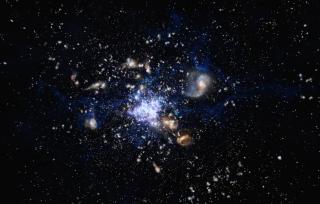Bibcode
Wardlow, J. L.; Simpson, J. M.; Smail, Ian; Swinbank, A. M.; Blain, A. W.; Brandt, W. N.; Chapman, S. C.; Chen, Chian-Chou; Cooke, E. A.; Dannerbauer, H.; Gullberg, B.; Hodge, J. A.; Ivison, R. J.; Knudsen, K. K.; Scott, Douglas; Thomson, A. P.; Weiß, A.; van der Werf, P. P.
Bibliographical reference
Monthly Notices of the Royal Astronomical Society, Volume 479, Issue 3, p.3879-3891
Advertised on:
9
2018
Citations
33
Refereed citations
30
Description
We present ALMA observations of the mid-J 12CO emission from
six single-dish selected 870-μm sources in the Extended Chandra Deep
Field-South and UKIDSS Ultra-Deep Survey fields. These six single-dish
submillimetre sources were selected based on previous ALMA continuum
observations, which showed that each comprised a blend of emission from
two or more individual submillimetre galaxies (SMGs), separated on 5-10
arcsec scales. The six single-dish submillimetre sources targeted
correspond to a total of 14 individual SMGs, of which seven have
previously measured robust optical/near-infrared spectroscopic
redshifts, which were used to tune our ALMA observations. We detect
CO(3-2) or CO(4-3) at z = 2.3-3.7 in 7 of the 14 SMGs, and in addition
serendipitously detect line emission from three gas-rich companion
galaxies, as well as identify four new 3.3 mm selected continuum sources
in the six fields. Joint analysis of our CO spectroscopy and existing
data suggests that 64(± 18){ per cent} of the SMGs in blended
submillimetre sources are unlikely to be physically associated. However,
three of the SMG fields (50 per cent) contain new, serendipitously
detected CO-emitting (but submillimetre-faint) sources at similar
redshifts to the 870 μm selected SMGs we targeted. These data suggest
that the SMGs inhabit overdense regions, but that these are not
sufficiently overdense on ˜100 kpc scales to influence the source
blending given the short lifetimes of SMGs. We find that 21± 12{
per cent} of SMGs have spatially distinct and kinematically close
companion galaxies (˜8-150 kpc and ≲ 300 km s-1),
which may have enhanced their star formation via gravitational
interactions.
Related projects

Molecular Gas and Dust in Galaxies Across Cosmic Time
Two of the most fundamental questions in astrophysics are the conversion of molecular gas into stars and how this physical process is a function of environments on all scales, ranging from planetary systems, stellar clusters, galaxies to galaxy clusters. The main goal of this internal project is to get insight into the formation and evolution of
Helmut
Dannerbauer